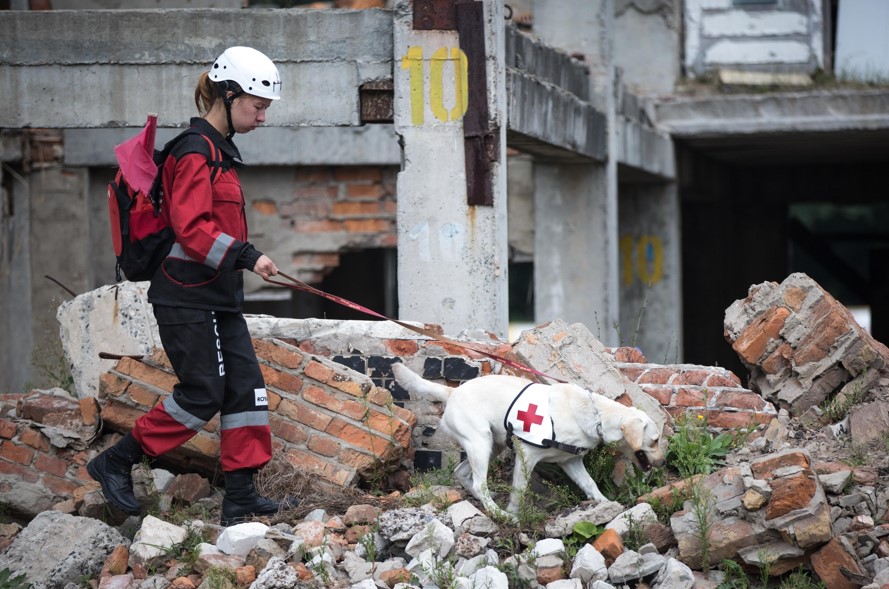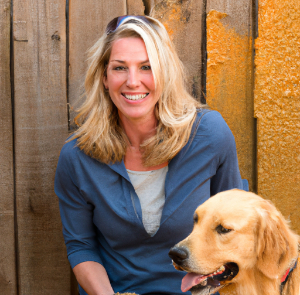
Search and rescue training for dogs can be a challenging task, especially if the handler makes mistakes during the initial stages of training. While the following suggestions can help solve common training problems, it's important to note that not every dog will respond in the same way. Some dogs may be unable to unlearn the mistakes made by their handlers, and the dog may revert to the behavior it was originally taught. Hence, it's crucial to get the training right the first time.
This problem is commonly faced by air-scenting dogs and scent-specific work. The dog may have found the hidden person, but after giving the signal, it won't lead the handler back to the hidden person. In some cases, the dog may even stop so far away from the hidden person that the handler cannot determine the location. To solve this problem, the handler must first identify and correct the miscommunication between the handler and the dog that was established during the early stages of training.
Solution:
One of the biggest challenges in search and rescue training is when a dog finds a hidden person but refuses to return to the handler. This can occur when the hidden person has been rewarding the dog too often during training. Depending on the dog's individual motivations, they may be more focused on the reward than the actual task at hand.
Solution 1: Building the Dog's Drive to Please You, the Handler
For dogs with a strong bond to their handler, this issue can be solved by eliminating the food or toy reward and focusing on praise and petting instead. Start with basic runaway exercises and gradually build up the distance between the handler and the hidden person. As the dog becomes more confident and enthusiastic about finding the person, allow them to lead you to the target without running ahead. If the dog does not return to the handler, gradually move closer until they do. Over time, you should be able to increase the distance between the handler and the hidden person while maintaining a reliable find and refind rate of 80%.
Solution 2: Substituting a Lower-Value Toy as a Reward
For dogs that are highly motivated by food or toys, a lower-value reward may be more effective. This can include a tug toy, a ball wrapped in cloth, or another object that the dog enjoys playing with. Toss the reward to the dog after they complete the exercise, and allow them to play with it until they willingly return it to the handler. As the dog becomes more familiar with the scenario, you can increase the distance between the handler and the hidden person until the dog is able to perform the exercise reliably.
One of the common problems faced in search and rescue training is the dog's tendency to abandon the problem after a successful find. This can be due to various reasons such as a lack of drive to continue the search, boredom, being inadvertently trained that the problem is over when the missing person is found, insufficient reward, or a lack of bonding with the handler.
Solution:
One common issue during SAR training is when the dog is able to locate the hidden person but refuses to lead the handler to the subject. This can occur in both air-scenting and scent-specific dogs, and is often a result of early training mistakes.
The handler may have unknowingly communicated to the dog that they already know the location of the hidden person, causing the dog to believe that their job is complete. This may happen when the handler becomes overly excited upon finding the hidden person and commands the dog to "show me" while pointing in the direction of the subject.
Solution:
To solve this problem, it's best to start with runaways. The handler should not know the exact location of the hidden person and allow the dog to lead the way. If the dog is trained to do a refind, now is the time to work on that skill. The handler should remain calm and issue a low-key "show me" command. If the dog is unsure what to do, the handler can wait for the dog to sort things out. Once the handler is shoulder to shoulder with the hidden person, the dog should be rewarded for a job well done.
Another related problem is when the dog only leads the handler to the hidden person if the handler is facing the right direction. In this case, the dog is picking up on subtle cues from the handler's body language and gaze, which signals the end of the exercise.
Solution:
To correct this issue, the handler should focus on maintaining a neutral body language throughout the training session. This will help prevent the dog from picking up on subtle cues that could interfere with the training. The handler should also make sure to reward the dog immediately upon reaching the hidden person.
The alert is a crucial aspect of search and rescue training. After the dog has found the hidden person, she should return to the handler and give a clear and unmistakable signal before leading the handler to the location of the find. Inaccurate alerts can be a problem when the dog is not properly trained to give a consistent signal. This can cause confusion and delay in finding the missing person.
Solution: Consistent Training and Reinforcement
Consistent training and reinforcement are key to resolving this problem. Start by teaching the dog a specific signal, such as barking or pawing, and reward the dog every time she gives the correct alert. Gradually increase the difficulty of the training exercises by hiding the person further away and in more challenging locations. Reinforce the correct behavior with treats and praise every time the dog gives the correct alert.
Dogs that divert from SAR work to chase game can be a major problem. There are several reasons why this might happen, including the dog's strong hunting/prey chase instinct, lack of motivation to find people, or previous encouragement to chase game. To prevent this problem, it's essential to train your dog from an early age.
Solution: "Leave it" Training
The key to solving the problem of a dog chasing game is to teach the "leave it" command. This command should be used as soon as your dog is adopted or when she's still a puppy. The actual words you use don't matter as much as the concept. When you say "leave it," you're communicating to your dog that she should get away from the object as quickly as possible because it's dangerous.
Start by using a low-value item such as a glove or hat. Put your dog on a leash and walk her near the object. Each time you do this exercise, approach the object from a different direction. When your dog notices the object, immediately reverse your walking and give the "leave it" command in a tone that communicates danger. Move away from the object as fast as you can. When your dog stops trying to look at the object, praise her and repeat the exercise once or twice a day.
As your dog improves, use more interesting objects and eventually, you can use live animals. Start with a head harness to prevent injury to your dog or the animal. It's also a good idea to refresh your dog's training by using the "leave it" command around a variety of objects and animals.
Some dogs are only interested in finding their owners and not in finding people in general. To solve this problem, it's essential to increase your dog's motivation to find people.
Solution: Increase Motivation
One way to increase motivation is to use positive reinforcement. Reward your dog every time she finds someone, whether it's you or someone else. You can use treats, toys, or praise. The more your dog associates finding people with positive rewards, the more motivated she will be.
Another way to increase motivation is to make the training sessions fun. Incorporate games and play into your training sessions to keep your dog engaged and interested. The more fun your dog has during training, the more motivated she will be to continue.
It is heartbreaking to see a previously well-performing SAR dog start to fail in their duties. One of the most common reasons is due to age, as the dog's senses can slowly diminish with time. Depending on the breed, most large dogs such as German Shepherds, Golden Retrievers, and Labrador Retrievers have a good working life until they are around eight years old.
Signs of Aging or Illness in Your SAR Dog:
It is essential to keep in mind that some illnesses, such as cancer of the spleen, may not be detectable through regular tests. In some cases, a SAR dog may start to fail due to a lack of faith from their handler. If you are an inexperienced SAR handler and are feeling discouraged, it is crucial to work with a trainer who can set up scenarios where your dog cannot fail and help you regain confidence in their abilities. Additionally, it is crucial to understand that even the best SAR dog can have an off day or face difficulties due to environmental factors.
Losing the scent is a common problem, especially in scent-specific dogs. If your dog has drive, stamina, and enthusiasm, but loses the scent after a short distance, it can be a complicated issue to solve. Weather conditions, such as temperature, can affect the scent, making it more difficult for the dog to detect. For example, a person who has exercised gives off more heat and scent when it's cool or cold outside, but if they are hidden under a waterproof covering or in warm weather, the scent is harder for the dog to detect.
Chemicals can also temporarily block a dog's sense of smell, making it harder for them to detect a weaker scent. Short-nosed breeds, such as pugs and Boston terriers, and albino dogs may also have a harder time detecting odors. On the other hand, small dogs, like Jack Russell terriers and papillons, have the same scenting ability as larger breeds.
Handler error can also play a role in a dog seeming to lose the scent. If the handler doesn't trust the dog, they may re-command the dog to follow a different scent, causing confusion. Talking to the dog while she's working can also distract her and cause confusion.
Solution:
To overcome this problem, it's important to always give your dog time to work out the problem without interfering. Avoid talking to your dog while she's working, and try to trust in her ability to follow the scent. If the dog rests her nose for a moment, don't assume she has lost the scent. It's also helpful to train in areas where the scent is not destroyed by chemicals or weather conditions.
It's impossible to tell a dog to forget what you've been doing and undo the mistakes you've made during training. Dogs never forget, and in some cases, they may revert to what they were first taught. This is why it's crucial to do it right the first time.
Solution:
To prevent this problem, take the time to research and understand the proper training techniques for your specific breed of dog. Seek out professional help if needed, and be patient and consistent with your training.
In conclusion, training a search and rescue dog can be a rewarding but challenging task. By being aware of common problems and taking steps to overcome them, you can ensure that your training is successful and your dog is well-prepared for the important job of finding lost individuals.
